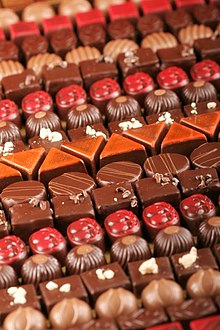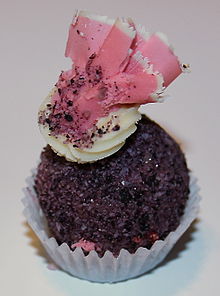Praline
The praline or praline is a bite-sized product made from chocolate with fillings that determine the taste ( ganache or nougat , nuts , pistachios , liqueur , marzipan or similar) or fruits. Due to their elaborate production, pralines are considered the culmination of the art of chocolatier .
Demarcation
The basic requirement for the designation praline is a chocolate content of at least 25%. If chocolates do not reach the proportion of 25% couverture , one legally only speaks of confectionery . Furthermore, the confectionery must be bite-sized in order to be declared as a praline.
Furthermore, “praline” refers to a dessert specialty from the French region of Rhône-Alpes ( Lyon ). It is a mass of (not caramelized) sugar and almonds , which is usually pink in color and is used both as an ingredient in brioches and as a topping on tartes for dessert.
History of chocolate making
The German chef of César de Choiseul , Comte de Plessis-Praslin, is considered to be the inventor of the praline . The count was Marshal of France , Minister King Louis XIV and his envoy to the Reichstag in Regensburg. The inventor of the praline named his almond and sugar confectionery after his master.
There are basically two different manufacturing processes. The original procedure consisted of immersing e.g. B. nuts, almonds or candied fruits in caramel syrup or z. B. of shaped marzipan pieces in liquid chocolate mass. In 1912, Jean Neuhaus, then owner of the “Confiserie et Chocolaterie Neuhaus-Perrin” in Brussels, developed the process of pouring metal molds with liquid chocolate, filling them with chopped nuts, dried fruit, liqueur and other things and sealing them with a chocolate chip. After cooling, the finished pralines could be thrown out of the molds. In the further course machines were developed that could fill small chocolate bars with this process. These processes led to the industrialization of praline production.
Today, small manufacturers in particular - often by hand - try to give the praline a special value again with high-quality ingredients and special fillings such as spices, fresh fruit or tea infusions.
Belgium and Switzerland are considered to be the strongholds of chocolate makers . The most famous chocolate manufacturers are:
- in Belgium: Godiva , Neuhaus and Leonidas and numerous smaller chocolatiers. Jean Neuhaus from Neuchâtel , Switzerland, settled in Brussels in 1857 and opened a pharmacy in which he initially sold liqueur sticks for stomach problems. His son Frédéric finally persuaded him to switch to the confectionery trade. The grandson Jean Neuhaus developed the hollow molding process that is still practiced today.
- in Switzerland: Lindt & Sprüngli , Suchard , Confiserie Sprüngli
Well-known types of pralines
- Seafood (chocolate) - Belgian pralines
- Mozartkugeln
- Hallor balls
- Truffles (chocolates)
- Brandy beans , invented by Hugo Asbach
Individual evidence
- ^ Ordinance on Cocoa and Chocolate Products (Cocoa Ordinance) , accessed on December 14, 2013
- ↑ a b Josef Loderbauer: The confectioner's book in learning fields . Verlag Handwerk und Technik, Hamburg 2009, ISBN 978-3-582-40203-5 .
literature
- Supplement to the Baedeker Allianz travel guide Belgium. Verlag Karl Baedeker, Ostfildern 2010 (9th edition).



